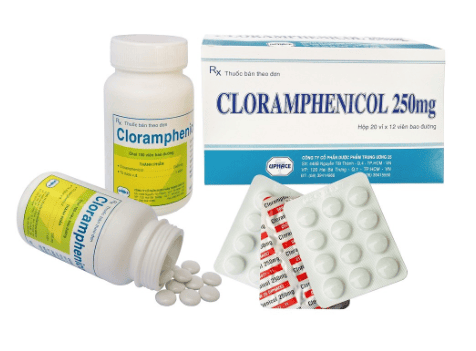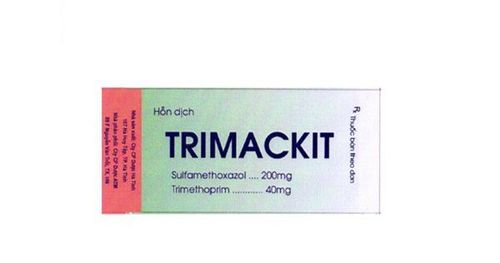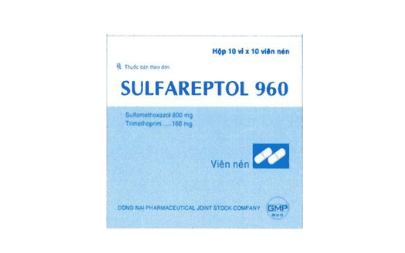This is an automatically translated article.
Sulfamethoxazole is a potent lipid-soluble active ingredient and has a smaller volume of distribution than trimethoprim, when combining Trimethoprim with Sulfamethoxazole in a 1:5 ratio, the plasma concentration of the drug will be 1: 20 - the optimal ratio. for the effect of the drug Ocebiso.
1. What is Ocebiso?
Ocebiso drug has the ingredient Sulfamethoxazol 400mg; Trimethoprim 80mg and excipients just enough. The drug is manufactured by Vietnam Pharmaceutical Joint Stock Company, Ocebiso drug circulates in Vietnam with the registration number VD-29338-18. The dosage form of the drug Ocebiso is dispersible tablets.
Sulfamethoxazole is a sulfamide in combination with trimethoprim, a synthetic pyrimidine derivative antibiotic, these two drugs are often combined in the ratio of 1 trimethoprim and 5 sulfamethoxazole to create a synergistic effect that enhances, increases the effectiveness of treatment and reduces drug resistance rate.
Sulfamethoxazole is a broad-spectrum antibiotic, active against many gram-negative and positive aerobic bacteria including: Staphylococcus, Streptococcus, Legionella pneumophila, Neisseria gonorrhoeae, Neisseria meningitidis, E. coli, Salmonella, Shigella, Enterobacter, Proteus mirabilis, Proteus indol positive, Klebsiella, Haemophilus influenzae ... Sulfamethoxazole resistant bacteria are: Enterococcus, Campylobacter and anaerobic bacteria.
Mechanism of action of the drug: Sulfamethoxazole thanks to its similar structure to para aminobenzoic acid (PABA), thereby competing with PABA thanks to its high affinity for dihydropteroate synthetase (inhibiting phase I of folic acid synthesis of folic acid). bacteria). Sulfamethoxazole is an active ingredient that is well absorbed from the gastrointestinal tract, has high bioavailability, reaches plasma concentrations approximately equivalent to intravenous administration, is widely distributed into tissues and body fluids, including cerebrospinal fluid, and is metabolized in the liver. and is eliminated mainly in the urine in unchanged form and as metabolites. The half-life of Ocebiso is 9-11 hours in normal subjects and longer in patients with renal failure.
2. What are the effects of Ocebiso?
Ocebiso is indicated in the following cases:
Treatment of infections caused by susceptible bacteria; Urinary and genital infections; Respiratory infections: bronchitis, pneumonia, sinusitis, otitis media; Gastrointestinal infections.
3. Contraindications of the drug Ocebiso
Who should not use Ocebiso?
Liver failure, severe kidney failure; Macrocytic anemia; Pregnant woman; Newborns, premature babies People who are sensitive to the drug.
4. Dosage and how to use Ocebiso
Each drug and pharmaceutical product is produced in different forms and has different uses, so the usual routes of drug administration will be divided into drug forms: oral drugs, injection drugs, external use and suppositories. Carefully read the instructions on how to use Ocebiso from the instructions for use of the drug, do not arbitrarily use other routes not stated on the instruction sheet. Ocebiso is used orally, before - after eating. Dosage of Ocebiso is as follows:
Urinary tract infections: Use Ocebiso for 10 days, take 1-2 tablets of Ocebiso 480mg each time, 2 times a day. Respiratory tract infections: treat Ocebiso for 10 days, take 1-2 tablets of Ocebiso 480mg each time, 2-3 times a day. Gastrointestinal infections, bacillus dysentery: treat Ocebiso for 5 days, take 1-2 tablets of 480mg each time, 2 times a day.
5. Notes before taking Ocebiso
Patients with renal failure, elderly patients receiving long-term treatment with high doses of Ocebiso drug should monitor the risk of adverse effects on folic acid metabolism and blood of the patient. Note during pregnancy: Ocebiso used in pregnancy can cause adverse effects (miscarriage, teratogenicity, fetal malformation...) at any stage of pregnancy, especially is the first 3 months, so it is best not to use Ocebiso for pregnant women. If you must use Ocebiso, you should consult your doctor or pharmacist before making a decision. Note during lactation: Ocebiso can be passed to the baby through breastfeeding, so it is best not to or limit the use of Ocebiso during breastfeeding.
6. Side effects of Ocebiso
Side effects of Ocebiso:
Digestion: nausea, vomiting, diarrhea, stomatitis, glossitis...; Kidney: interstitial nephritis, renal failure, kidney stones; Skin: skin rash, blistering, urticaria, pruritus, Stevens - Johnson and Lyell syndrome; Blood: macrocytic anemia caused by folic acid deficiency, hemolytic anemia, decreased blood cells... Other undesirable effects of Ocebiso: cholestatic jaundice, increased K + blood, tinnitus, hallucinations. Intravenous administration of Ocebiso can cause phlebitis and tissue damage.
7. Drug interactions of the drug Ocebiso
When using Ocebiso at the same time, two or more drugs often have drug interactions that lead to antagonism or synergism: The risk of nephrotoxicity increases when Ocebiso is used concomitantly with ciclosporin. Folate antagonists such as methotrexate, pyrimethamine... when used concurrently with sulfamethoxazol in Ocebiso may increase the incidence of megaloblastic anemia. Ocebiso medicine has ingredients Sulfamethoxazol 400mg; Trimethoprim 80mg and excipients just enough. The drug is prescribed by doctors to treat certain infectious diseases. To ensure effective treatment and avoid unwanted side effects, patients need to strictly follow the instructions of the doctor, professional pharmacist.
Follow Vinmec International General Hospital website to get more health, nutrition and beauty information to protect the health of yourself and your loved ones in your family.
Please dial HOTLINE for more information or register for an appointment HERE. Download MyVinmec app to make appointments faster and to manage your bookings easily.













